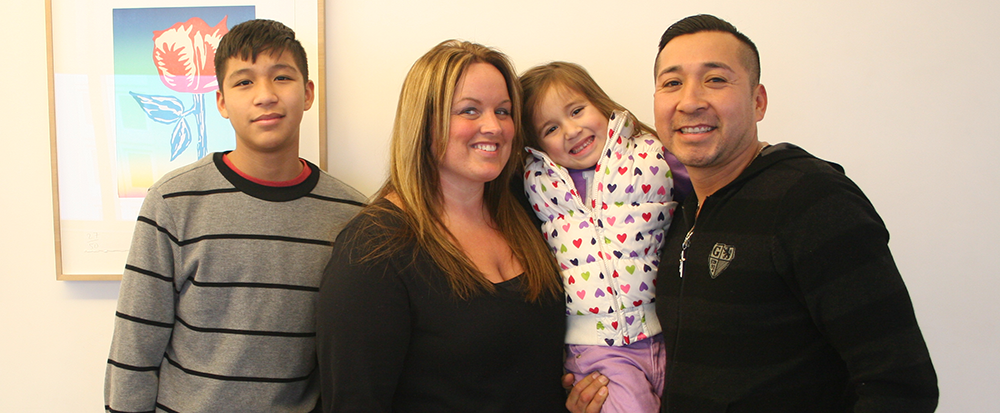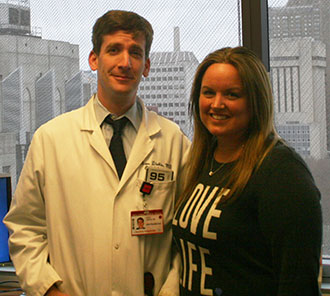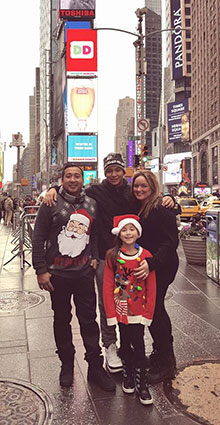
By Allyson Tlacoxolal
I suffered from headaches all throughout my twenties, and I had always thought they were migraines. The headaches got much worse when I was pregnant — they affected my vision and I would actually lose my vision briefly (but entirely) several times a day. It was scary!
One day my neurologist was looking behind my eyes and thought the optic nerve looked swollen. I went to Wills Eye Hospital in Philadelphia, where I was finally diagnosed with pseudotumor cerebri. Of course it was great to finally know what was wrong, but it didn’t seem as if there were anything anyone could do for me.
These episodes lasted throughout my pregnancy, and I had to deliver five weeks early because my doctors thought I was going blind.
That was five years ago. After I had the baby, I was taking Imitrex for migraines and my neurologist put me on Diamox to relieve the pressure in my head, and I seemed to improve a bit. I still had constant headaches, but at least my vision was better. I learned how to mostly manage the headaches, but they affected my job and my social life — I had to take lots of breaks from the computer, and I missed work many days when the headaches were the most severe. I also missed out on a lot of family events — sometimes I simply felt too sick to join in the fun.
I was also having other symptoms, but at the time I didn’t connect them to the headaches. Several times I went to my regular doctor for what I thought was an ear infection. I kept hearing this swishing noise in my head, like a pounding heartbeat. Even when it was completely silent, I heard the noise in my head. My doctor said it was wax buildup in my ears and recommended that I clean them out. The noise got progressively worse over time, keeping me up at night and making it very hard to concentrate.
But in December of 2013, I was at my desk at work when all of a sudden I got a really bad headache and blurred vision. There was a meningitis outbreak going on at the time, so I went to my local hospital and insisted on a spinal tap. The good news was that I didn’t have meningitis; the bad news was that the pressure in my cerebrospinal fluid (CSF) was dangerously high.
Doctors at the local hospital recommended I have a shunt placed in my brain to relive the pressure, which would help with the headache and vision symptoms. I wanted to have the procedure done at a top hospital, and my father had a friend who knew of Dr. Theodore Schwartz at NewYork-Presbyterian/Weill Cornell Medical Center. After making a call to Dr. Schwartz, I knew the right decision was to go to the best. I took a two-hour ambulance ride to New York.
The night before the surgery they did this special kind of MRI scan called an MRV — magnetic resonance venography, which uses MRI imaging to look at your veins. The next morning, when I was getting ready for surgery, Dr. Schwartz came in and said, “good news — we found a narrowing in a vein in your brain on the MRV.” I remember thinking, “how is that good news?”
The good news was that Dr. Schwartz said Weill Cornell Medicine was conducting a clinical trial for pseudotumor and it sounded like I’d be a perfect candidate. Like many people with pseudotumor cerebri, I had what’s called venous sinus stenosis, or a narrowing in some of the veins in my brain. The trial was to open up that narrowing with a little stent that could be done with minimally invasive surgery — just a little incision in my groin, and the stent would be snaked up through blood vessels to my brain.
My whole family was with me in the hospital that day, since we all thought I was having the shunt surgery. We all had a lot of questions. The doctors were so patient, and so thorough, in answering all of them.
This was when I found out I would be patient number 10 in the trial. I was really nervous about it, but at least I wouldn’t be the first! Together we all decided that this was the best thing to do, that the clinical trial was the way to go. After spending all that time with the doctors I knew I was in the best hands ever.
The surgery was on December 19, 2013, just a few days before Christmas. From the moment I entered the operating room, the doctor was by my side. He kept me informed about everything that was happening, while it was happening.
My biggest fear was that I had to be awake for the first hour while they tested to confirm the presence of the stenosis. I was as scared as could be that I was going to feel something, but the doctor kept explaining to me what was going on and reassuring me I would be okay. He kept me talking, asking me to tell him about my family, and constantly checking in to be sure I was okay. I can honestly say I was perfectly calm and relaxed, knowing that this procedure was going to make my years of pain go away.
The first hour was spent doing the test, and I remember praying as I lay on the table, please let me pass this test, because I need to be fixed. Luckily for me, I passed, then it was time to move on to the next stage, and the doctor went out to talk to my family. I remember him coming back in and telling me everyone had sent me their love, and that’s the last I remember until I woke up in recovery.
Immediately after the surgery I had quite a headache, as if I had been hit in the head, but the years of pulsating heat back in my head was gone. It was amazing! After a few hours and some pain medications, I felt better. I spent the night in the ICU and the care I received was amazing. The very next day I was up and walking. I had hardly any pain in my groin from the incision, just a residual headache. I truly could not believe how amazing I felt.
 Two days after the surgery I was able to go home, just in time for Christmas. I was on steroids and blood thinners, and I had headaches off and on for a week or so. But by New Year’s Eve, just 12 days after the surgery, I felt great — no headache, no noises in my ears, no trouble with my vision, nothing. I don’t think I’d ever felt better in my life. It was like a miracle!
Two days after the surgery I was able to go home, just in time for Christmas. I was on steroids and blood thinners, and I had headaches off and on for a week or so. But by New Year’s Eve, just 12 days after the surgery, I felt great — no headache, no noises in my ears, no trouble with my vision, nothing. I don’t think I’d ever felt better in my life. It was like a miracle!
It’s been just about three months since the surgery and I feel great. Before the surgery, my life was full of headache pain, constant noise in my ears, and loss of vision. My life now is amazing — headache-free, noise-free, and none of the vision “episodes” that I had before. I feel like I get better every day. (The photo on this page is from my three-month follow-up visit.)
I tell at least one person a day how amazing it is that we have a procedure like this. This team is truly in the business of changing people's lives, and I would recommend that anyone given the opportunity to have this procedure should take action and trust the doctors. They are the most amazing team you will ever have the opportunity to have care for you. This was the best decision I ever made — it changed my life!
Find out more about the stenting procedure

Update, December 19, 2016: "Just wanted to thank you again for changing my life. The family and I celebrated yesterday in the city as we have done the past 3 years and the day would not have been complete without reaching out to thank you for making it happen.
After 8,182 YouTube views and countless conversations with people that connected with me for advice/support via Facebook, I have truly enjoyed each and every moment I get to talk about how much better you have made my life. As always, please let me know if there is anything/anyone I can speak with that struggles with pseudo tumor."
We heard from Allyson again in December 2017:
Four years ago today at this very time, I was having my surgery. 12/19 is a very special day to me and my family and it changed my life. I always reflect on this day about how truly lucky I was to have met you and received the amazing care I did in NY. It is so amazing to be happy and healthy but also to be an inspiration to so many patients that struggle with pseudo tumor.
Thanks to your video and our story, I am constantly getting messages on social media from people looking for relief and support. It has been a great feeling to be able to help people along the way and to know that my story can help others. #PayItForward Just wanted to say thanks again from the bottom of my heart. I am truly honored to have been your patient #10. Merry Christmas and happy 2018!!!
Allyson Tlacoxolal